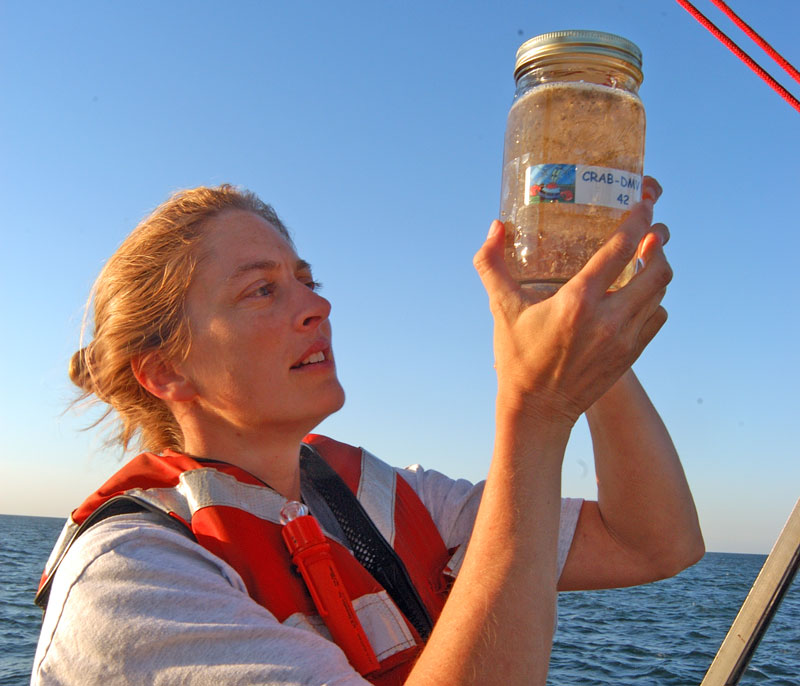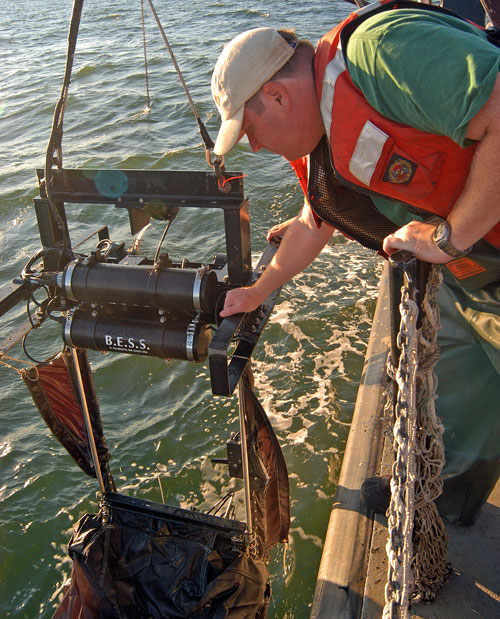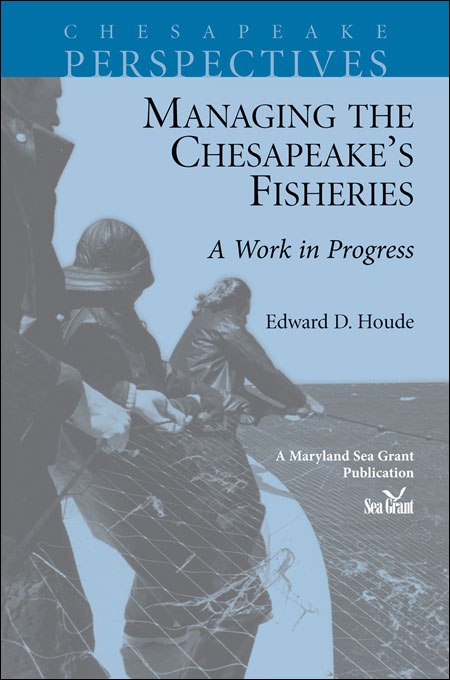Knauss legislative fellowships in Congress help build careers — and they're fun and educational. See our video and fact sheet for details.
The Maryland Sea Grant bookstore is closed from December 10 to January 3.
New Clues to How Crab Babies Make It Back to the Bay
Every spring, female crabs near the mouth of the Chesapeake Bay spawn their young. Nearly all of the hatched larvae are swept into the open ocean by outflowing surface water. Adrift in the sea, they feed on even tinier marine creatures and speed through seven growth spurts over a month or so. Finally, as the little swimmers are just starting to look like crabs, some of them manage to make it back into the Bay and get a chance to grow into adults.
Chesapeake Bay scientists have spent decades trying to figure out how these boomerang babies — larval crabs called megalopae — get back to the estuary. Are they carried in by nighttime tides? By underwater currents? Or by massive wind-driven inflows of ocean water? In search of answers, scientists mounted two research cruises in 2005 and 2006 to gather new data on the crab homecoming in the Chesapeake and Delaware Bays. Understanding these details might someday help regulators to fine-tune management of crab harvests.
Megalopae may not hitch rides on nighttime flood tides to get into the bay, according to a new analysis of the cruise data. Instead, the study provides new backing for the long-standing theory that winds blowing down the Atlantic coast may be more important than tides. The combined effect of coastal winds and earth’s rotation push large volumes of water from the ocean into the bay — and megalopae go along for the ride.
“If the megalopae are just lucky enough to be offshore of the mouth when there is one of these wind events, they could be pushed into the bay,” says Elizabeth North, a fisheries oceanographer with the University of Maryland Center for Environmental Science (UMCES) and chief scientist on the research cruises. “The wind events are not as regular as tides, but they can carry a lot of water into the estuary, along with the crab larvae.”
 |
 |
| Researcher Elizabeth North (top), a fisheries oceanographer, helped to lead a series of research cruises to study how blue crab larvae return to the Chesapeake and Delaware Bays after undergoing early growth phases in the coastal ocean. The scientists used a special multi-compartment netting rig (above, with researcher David Kimmel) to collect larvae at various depths in the water and infer their swimming behaviors. Credit: Michael W. Fincham |
Marine scientists have a term for the transport of tiny crabs from ocean to estuary: larval ingress. If regional ocean wind patterns play a big role, then so might longer-term climate cycles that influence those winds. Understanding links between wind and climate could help answer a fundamental question for fishery managers. “What creates big years and small years in the number of young crabs in the Bay?” says William Boicourt, an oceanographer at UMCES’s Horn Point Laboratory and one of the scientists who helped establish the regional wind theory. “Understanding that could inform management decisions.”
Boicourt, North, and a former UMCES graduate student, Jeffrey Biermann, recently published their findings about megalopae movements into the Chesapeake and Delaware Bays in the journal Estuaries and Coasts.
To determine which type of natural force was mostly responsible for the crab ingress, the researchers considered and gathered data relevant to each.
One force was nighttime flood tides flowing near the surface of the estuary. Crab scientists generally agree that once the young crabs enter the estuary from the ocean, these tides carry them farther up the bay. The crabs may sense the spike in saltiness and turbulence that accompanies the flood tide, which tells them it’s time to swim toward the surface to catch a ride.
Some scientists have also proposed that this nocturnal flood tide taxi service contributes to the annual crab ingress from the ocean into the bay. In addition to flood tides and regional winds, the deep flow of dense, salty water into the estuary from the ocean may also carry some megalopae in.
North and her team hoped to figure out which of these rides was important to the crab ingress in the Delaware and Chesapeake Bays. To do that, they needed to collect data on how deep the larvae are in the water column — near the surface or farther underwater. They also needed to find out when during day and night that the larvae are at various depths and where they are in relation to the bay — near the mouth or farther out.
Getting that data took a lot of work. During the cruises, North’s team towed a high-tech net through the water at the mouths of both bays at regular intervals over the day and night. The net is made up of multiple compartments that could be opened selectively to trap megalopae at different depths.
After taking account of the number of megalopae plucked from the water at different depths and times, the researchers found no clear evidence that nighttime tides were playing an important role. The data didn’t show that the megalopae were swimming up to the surface and staying there to catch rides on the nighttime tides as they approached either the Delaware or Chesapeake Bay.
That left a possible role for other forces like coastal winds and the deep, salty ocean flow.
The scientists knew that while the megalopae reside in the coastal ocean, they swim mainly near the surface, where they feed on plankton. But previous research by other scientists suggested that as the crab larvae drift toward the bay mouth, they sense chemical cues in the plume of water flowing outward from the estuary. At that point, the tiny paddlers flip into a swimming pattern that North describes as “down during the day and up at night.” It’s a change driven by sunlight, not flood tides, and it apparently helps to prepare them for survival within the estuary.
North and her colleagues found this up-down behavior “everywhere,” North says. “We saw it just within the mouth, at the mouth, and up to 40 kilometers [25 miles] offshore of the mouth.” Seeing that swimming pattern so far outside the bay mouth was a surprise. North says it’s possible that extra-heavy flows of fresh water from rivers in 2005 and 2006 might have extended the chemical scent of the estuaries farther out to sea than usual.
The finding indicated a possibly big role for coastal winds in larval ingress, because the winds can exert an effect throughout the water column and regardless of time of day. “These wind events can push water into the bay at all depths,” North says, “so if [larvae] are in the water column anywhere, day or night, the wind events could push them into the bay.”
The up-and-down swimming pattern in the coastal ocean could also allow some megalopae to ride deep inflows of salty ocean water into the bay. Crab ingress season occurs during the summer and early fall, North explains, when the days are still longer than the nights. That means megalopae spend more of their time below the surface, where the inflow can carry them through the mouth of the bay and into the estuary.
If these findings are confirmed by more research, coastal winds may do the heavy lifting of the larval ingress, which raises the possibility of forecasting. “With this information, we are one step closer to understanding how cycles in environmental conditions influence the ingress of young blue crabs and their abundances from one year to the next,” North says.
She says the next step is to link wind patterns with the number of young crabs in the bay and multi-year climate cycles that are relatively predictable — like the Pacific’s El Niño. Forecasting the number of young crabs that make it back into the bay might help fishery managers fine-tune their decisions about how many crabs to harvest — or as North puts it, “when to be a little more conserving of the resource, if years of poor ingress are expected, in order to maintain steady harvests over time.”
Photo, top left: When crab larvae reach their final growth stage in the coastal ocean, they turn into a megalopa like this one — and then head back into coastal estuaries to grow to adulthood. This megalopa is about 3.5 millimeters long, or roughly the width of two grains of sand. (Every unit on the scale is 1/15 mm.) Credit: Alicia Young-Williams, Smithsonian Environmental Research Center
See all posts from the On the Bay blog







